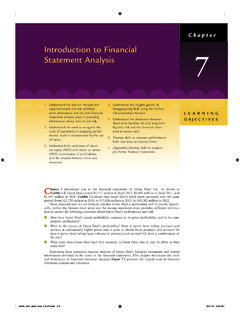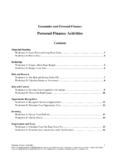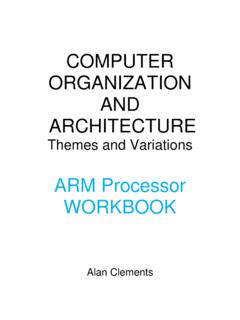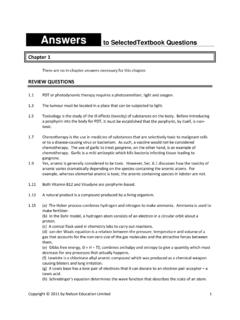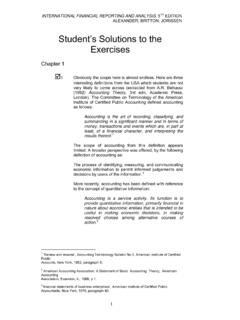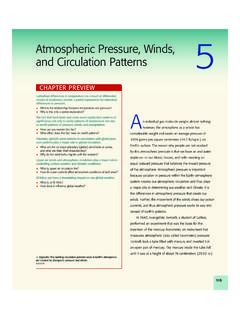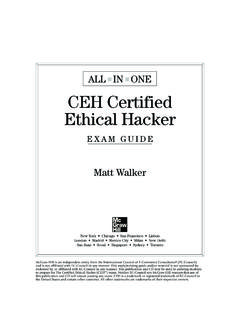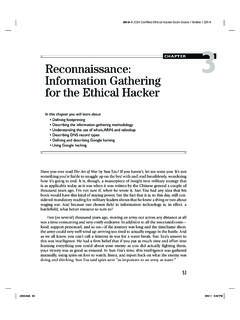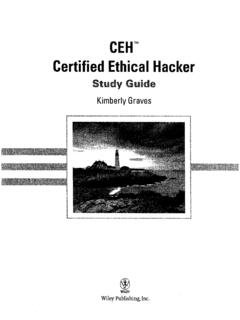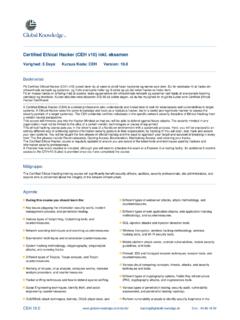Transcription of EC-Council Certified Ethical Hacker v6 - Cengage
1 EC-Council Certified Ethical Hacker Cheat Sheet Exercises How to Use the Cheat Sheets Students often report that the most difficult thing about the CEH exam is the terms, tools, numbers, log files, packet dumps and example scripts. None of these items can be understood without the concepts that give them meaning, but once the concepts are clear, it is still necessary to be exposed to the raw data until they are second nature. Cheatsheets are exercises that can be used to assist with memorization and refresh before the time of the exam. They are not comrehensive reference guides. They are designed to provide only enough data to trigger the memory or assess what needs to be better understood. Having a list of everything at your fingertips is helpful on the job but is almost useless as a study tool. You must interract with the data in order to convert it to information and own it. Since the exam is not open book, the goal is in fact to get to a point where you no longer need the cheat sheets at all.
2 Each cheat sheet is a concept object. These are examples to get you started and provide enough information to establish a grasp of the object at hand. Print them out, and hand copy each one in your own writting to another sheet of paper. Arrange the material in your own way, and add notes to them as you study. Practice this at least three times. On the third try you may find you can copy the entire thing without looking at the original. Then you have mastered it, and will have problems recalling important data druing the real exam. In summary, to get the most out of these study aids, follow these simple tips: 1. Check back often for new versions 2. Print them out and copy them by hand to a blank piece of paper; three times. 3. Take additional notes, fill in any information that seems to be missing Chapter Map for the Cheat Sheets 01 Ethical Hacking CEH Prerequisites Terms and Definitions Methodologies 02 Hacking Laws Legal Issues 03 Footprinting Domain Name Service 04 Google Hacking Google Hacking 05 Scanning NMap Scan Types TCP Handshake Ports and Protocols 06 Enumeration
3 Enumeration 07 System Hacking Password Cracking 08 Trojans and Backdoors Trojans and Malware 09 Virus and Worms Virus Trivia 10 Sniffing, Spoofing, Hijacking Sniffing MAC Addresses Internet Protocol Internet Control Message Protocol User Datagram Protocol Transmission Control Protocol 11 Social Engineering Social Engineering 12 Denial of Service DoS and DDoS Tools 13 Buffer Overflows Buffer Overflows
4 14 Web Servers and Applications HTTP and URLs 15 Wireless Networks Wireless Technology Wardriving 16 Cryptography Cryptography 17 Hacking Linux Linux Operatinig System Linux Commands 18 IDS, Firewalls, Honeypots Firewalls and IPTables IDS and Snort ** Misc Cheat Sheets Command Line Tools Syntax Recognition Random Recall Exercise CEH Prerequisites There are entry level security classes, but security is not an entry level subject.
5 In order to be comfortable with the CEH training, pre-requisites are assumed and test items will involve topics that time might not permit covering during the live trainging. Prior to training, try to refresh your skill sin the following areas. The more time spent on this step the more comfortable the training experience will be. Know the basics of Information security Concepts such as "CIA (Confidentiality, Integrity, Availability) Coverage would have come during CompTIA or CISSP training Know the basics of networking Physical layer, cabling, hardware devices The function of switches, routers, firewalls IP Addressing, Subnetting and CIDR notation Know how to convert numbers Decimal, Octal, Binary; in all directions and combinations Know the basics of Cryptography There is a module in the class on Crypto, but there may not be time to cover it in class. Sufficient coverage would have come during CompTIA Security+ or CISSP Know the OSI model Application 7 Service protocols Presentation 6 Data formats Session 5 Authentication, Cryptographic agreements Transport 4 Ports, logical service to service connections Network 3 Network to network delivery Data Link 2 Host to host links, contention Physical 1 Media Know how to use a Windows PC Be familiar with the Windows Graphical User Interface Find toolbar icons, manage folders and files, use network shares The labs in this class are difficult and must move rapidly.
6 Slowdowns for poor PC skills may result in just watching the demonstration at times, please be understanding of this and courteous to the other students. Terms and Definitions Read the following terms and makwe sure you know their meaning. Look up any that you are not comfortable with. On your own cheat sheet, jot down any additional terms you run across that struck you as new or odd. Term Definition Hax0r Hacker Uberhacker Good Hacker L33t Sp33k Replacing characters to avoid filters Full disclosure Revealing vulnerabilities Hacktivism Hacking for a cause Suicide Hacker Hopes to be caught Ethical Hacker Hacks for defensive purposes Penetration Test Determine true security risks Vulnerability Assessment Basic idea of security levels Vulnerabilty Researcher Tracks down vulnerabilities White hat Hacks with permission Grey hat Believes in full disclosure Black hat Hacks without permission White Box A test everyone knows about Grey Box A test with a very specific goal but unspecific means Black Box A test no one knows is happening Threat Potential event Vulnerability Weakness Exposure Accessibility Exploit Act of attacking TOE Target of
7 Evaluation Rootkit Hides processes that create backdoors Botnet Robot network that can be commanded remotely Buffer Overflow Hijack the execution steps of a program Shrinkwrap Code Reused code with vulnerabilities Methodologies This class tells a story, and understanding that story is far more important than memoriing these lists. Think about what actions are taken during each phase, and notice how they logically progress. The phases of an attack 1. Reconnaissance Information gathering, physical and social engineering, locate network range 2. Scanning - Enumerating Live hosts, access points, accounts and policies, vulnerability assessment 3. Gaining Access Breech systems, plant malicious code, backdoors 4. Maintaining Access Rootkits, unpatched systems 5. Clearing Tracks IDS evasion, log manipulation, decoy traffic Information Gathering 1. Unearth initial information What/ Who is the target?
8 2. Locate the network range What is the attack surface? 3. Ascertain active machines What hosts are alive? 4. Open ports / access points How can they be accessed? 5. Detect operating systems What platform are they? 6. Uncover services on ports What software can be attacked? 7. Map the network Tie it all together, document, and form a strategy. Legal Issues Be able to describe the importance of each of these items. The exam will not go into depth on this, just be prepared to identify the issues. United States Computer fraud and abuse act Addresses hacking activities 18 1029 Possession of Access Devices 18 1030 Fraud and Related Activity in Conncetion with Computers CAN-SPAM Defines legal eMail marketing SPY-Act Protects vendors monitoring for licence enforcement DMCA - Digital Milenium Copyright Act Protects intellectual property SOX - Sarbanes Oxley Controls for corporate financial processes GLBA - Gramm-Leech Bliley Act Controls use of personal financial data HIPPA - Health Imformation Portability and Protection Act Privacy for medical records FERPA - Family Educational Rights and Privacy Act Protection for education
9 Records FISMA - Federal Information Security Management Act Government networks must have security standards Europe Computer misuse act of 1990 Addresses hacking activities Human Rights Act of 1990 Ensures privacy rights Domain Name Service DNS is critical in the footprinting of a target network. It can sometimes save the attacker a lot of time, or at least corroborate other information that has been gathered. DNS is also a target for several types of attack. Fields in the SOA record: (Time in seconds) 1882919 7200 3600 14400 2400 Serial Refresh Retry Expiry TTL Requesting a zone transfer nslookup; ls -d dig AXFR host -t AXFR Using Whois whois Regional Internet Registrars ARIN (North America) APNIC (Asia Pacific Region) LACNIC (Southern and Central America and Caribbean) RIPE NCC (Europe, the Middle East and Central Asia) AfriNIC (Africa) Attacks against DNS servers Zone transfers Information gathering shortcut Zone poisoning Breach the primary server and alter the zone file to corrupt the domain Cache poisoning Send false answers to cache servers until they store them Reflection DoS Send bogus requests into a chain of servers that do recursive queries Google Hacking An attacker will use Google to enumerate a target without ever touching it.
10 The advanced search syntax is easy to use but can be quirky at times. It takes practice and experimentation. Using Advanced Search operator:keyword additional search terms Advanced Operators site Confines keywords to search only within a domain ext File extension loc Maps location intitle Keywords in the title tag of the page allintitle Any of the keywords can be in the title inurl Keywords anywhere in the URL allinurl Any of the keywords can be in the URL incache Search Google cache only Keyword combinations passsword | passlist | username | user login | logon Administrator | Admin | Root Prototype | Proto | Test | Example Examples (ceh ecsa lpt) allinurl:login logon -ext:html -ext:htm -ext:asp -ext:aspx -ext:php Nmap Scan Types Nmap is the de-facto tool for footprinting networks. It is capable of finding live hosts, access points, fingerprinting operating systems, and verifying services.
